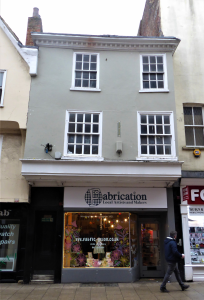
40/24 Coney Street

Detail from An Inventory of the Historical Monuments in City of York, Volume 5, Central131)
House, No. 24, was built c. 1600, possibly incorporating parts of an earlier structure. It was a timber-framed house of three storeys, jettied on the street front, some 17 ft. wide and 42 ft. deep, giving two good rooms one behind the other on each floor. In the mid 18th century the front of the second floor was set back to eliminate the upper jetty and to enable the first floor to be heightened at the expense of the second. The front rooms were curtailed by the insertion of a staircase. The front gable was cut back to a hip and the back part was re-roofed at a lower level, reducing its three storeys to two and semi-attics.
The front elevation is jettied above a modern shop front; the wall above is plastered, with 19th-century windows on the first floor and 18th-century windows above; the hipped roof rises behind a moulded block cornice with dentils, of late 18th-century date. At the back some original timber framing is exposed, under-built in brick. Inside, the front room has been enlarged to its original depth by the removal of the 18th-century staircase at this level. The latter has been reconstructed with 19th-century newels in the back part of the house. An encroachment has been made on the N. corner of the room to provide stairs for No. 22 next door. The ceiling beam support ing the first floor is cased but in the back room the ceiling beam is exposed and moulded. A cellar below is in part original but was enlarged towards the street in the 19th century. On the first floor in the front room the fireplace has an 18th-century surround. The 18th-century staircase has no newels, open strings and turned balusters with umbrella knops. On the second floor the front part of the house has a decorated plaster ceiling of the early 17th century, with roses and fleurs-de-lys in a pattern of quatrefoils and lozenges (Plate 164); the ceiling is cut short at the front where the wall has been set back to eliminate the jetty.
Demolition of buildings behind No. 24 revealed a roof truss (Plate 127) of late 13th or early 14th-century date, incorporated in later rebuilding. It had a flat tie-beam, common rafters, long passing braces, raking struts and a collar with tall unjowled crown-post, all, except for the larger tie-beam, of uniform scantling.
Number 40 Coney Street, now 24 Coney Street
Following a trip to the North Yorkshire County Records Office we were finally
able to find out further information about our building.
We discovered that in 1753 the building was left by Henry Thomson, Vicar of Coxwold in North Yorkshire, to his nieces Catherine Nelson and Frances Falkner by his sister Catherine both nee Preston
His father Thomas Thompson is listed in the 1671 Hearth Tax as having 30 hearths and tenants, which if Judges Court and all the properties are taken into account make sense
In 1762 they sell the building, the neighbouring buildings and Judges Court to John Elwick Jr Master Taylor. He already owns number 39. He is also married to Joseph Doughty’s Daughter, their grandaughter marries Thomas Ferrand, who is John Green’s great nephew
The building is tenanted by Onslow Barnett Apothecary
In 1780 he sells to John Croft plumber and Glazier, who in the 1818 trade directory is listed as in the DavyGate property, also bought initially from the Nelsons by John Elwick, so likely the building is rented to someone else
1825 Building is left to David Russell (perhaps the same who works with Ann Ward at the newspaper) and Robert Jennings, who is in 41. It is sold at Auction on the 7th April 1829 to Robert Dobson Bookeeper, who is now in number 39 for £1070.
The archive also has lease records for William Barber ladies Shoemaker (listed in the 1818 & 1823 directory but address not confirmed) in 1825 and 1829, although not Sotherans, so maybe there is a sublet as Barber is listed at St Helen’s Square in the 1829 trade directory
1829 Booksellers and Stationer Printers-Letter-Press
Sotheran Henry
1840 Chemists & Druggists Fall Thomas, 40 Coney street. Thomas Fall is left number 39 in 1866 by John Parsons perfumer and takes out a mortgage on number 40, however Parsons is listed as trading at number 2 in the 1829 Directory
1851 Chemists & Druggists Fall Thomas
1872 Fall Thomas chemist and Druggist
1861 Fall Thomas, chemist
1872 Fall Thomas chemist and Druggist
1876 Helley Robert, chemist and druggist
The census returns show that mrs fall continued to live in the building, until her death in 1900
1885 Singer Manufacturing Machine Company, Wm. H. Heslewood, manager
1886 Singer Manufacturing Machine Company, Wm. H. Heslewood, manager
1889 Singer Manufacturing Co. Fall, Mrs.
1893 Fall Mrs
Singer Manufacturing Co. (Abraham Cormack, district manager)
1895 Singer Manufacturing Co. sewing machine manufrs. George F. Hands, district manager
1898 Singer Manufacturing Co.
1900 Singer Manufacturing Co.
p
